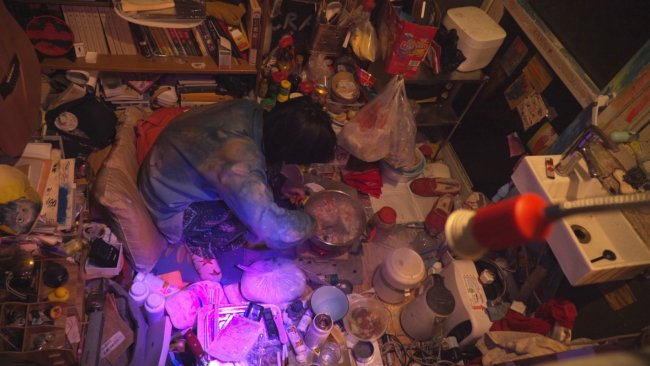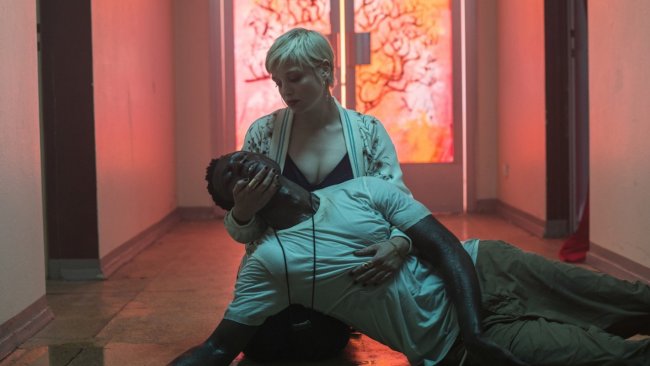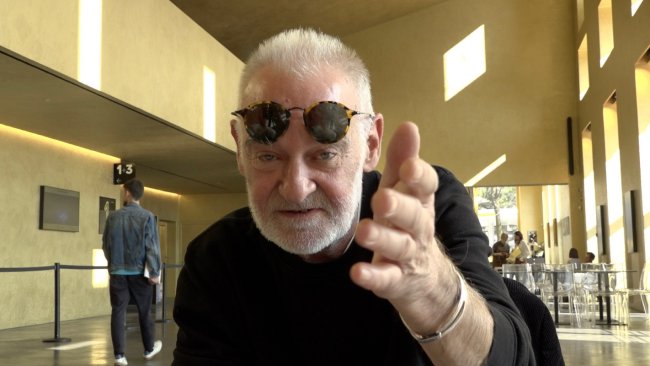The Woman Who Ran
[…] Hong’s feminist slant is also apparent in the narrative. The first two of Gam-hee’s meetings, with her friends Young-soon and Sou-young respectively, are disturbed by men, who knock at the door and make demands…
[…] Faced with her own unknowable desires, both actress and character effectively leave the narrative and return to the only place where sincerity and performance can finally be reconciled: the cinema.
Text: PM Cicchetti

Outside the Emu Cinema in Seoul, Kim Min-hee stops in her tracks. Just a few seconds earlier, as she was leaving the venue, her movements were dithery, her expression distracted. Now, she stands still, seemingly checking something on her phone. The camera, behind her back, holds its position at a discreet distance. Suddenly, the actress turns on her heel and retraces her steps, going back into the theatre. Cut. In an empty, semi-darkened cinema, she lowers herself into a red chair and sits back. A gentle zoom brings her face, now slowly relaxing, into a medium close-up. Then, with a movement that feels almost like tenderness, the camera pans right, to frame the cinema screen.
Responding to any single title from Hong Sang-soo’s ever-expanding oeuvre is a nearly impossible task. His cinematic world is a revolving carousel, made up of familiar character-types and recurrent situations. One film bleeds into another, and each draws upon the viewers’ memories of previous films. This kind of cinema is less about the plot than it is about permutations, parallels, echoes. Minimal variations carry the force of major set pieces. Two characters drinking coffee instead of soju might well be the sign of an existential breakthrough.
In The Woman Who Ran, Hong casts his partner and long-time collaborator Kim Min-hee as a Gam-hee, a florist who, for the first time in five years, is taking a break from her closely-knit conjugal routine to reconnect with old female friends. The premise is ripe terrain for Hong’s speculative streak. In the past, these sorts of long-awaited reunions and chance encounters would often lead to episodes of unreliable narration, blurring the line between past and present, between what is and what might have been. As has been the case in most of Hong’s recent films, however, there is no trace here of the formalist gamesmanship that marked the first part of the director’s career. Gone are the old familiar patterns of bifurcation and narrative redoubling.
Which is not to say that The Woman Who Ran shies away from structural ingenuity. In fact, as the film progresses, subtle patterns begin to emerge. During each of the three main encounters, Gam-hee and her friends drink coffee. They talk about food. They make appreciative comments about the space they are in. Gam-hee tells her friends about her husband’s belief that people in love should spend every waking moment together. Similarly, moments of awkwardness pepper all these meetings: poorly chosen gifts, false memories, forgotten personal details, all hinting at the possibility that Gam-hee or her friends might have changed beyond each other’s recognition, or perhaps that their connections were never so genuine to begin with. On Sight & Sound, Ela Bettencourt takes this latter position, and reads these moments as possible signs of pretence, indicating a return of one of Hong’s core themes: the friction between performance and authentic selfhood.
Hong’s feminist slant is also apparent in the narrative. The first two of Gam-hee’s meetings, with her friends Young-soon and Sou-young respectively, are disturbed by men, who knock at the door and make demands, while her chance reunion with Woo-jin in the third segment happens in the shadow of the latter’s husband, a writer whom Gam-hee used to date. Compositional elements drive the point home: when they appear onscreen, men are consistently framed from the back, their faces hidden, as they corner the female characters in doorways. If blocking wasn’t enough, dialogues are even more explicit. Near the beginning of the film, Young-soon tells Gam-hee about a rooster from a nearby farm, who viciously picks on the hens just to prove his superiority. If we put these two elements together – pretence and male threat – it might be legitimate to assume that these women could be putting on a performance of self-determination, against the background of the ever-encroaching patriarchal norm.
However, if that is the case, then the meaning of their “performance” should be qualified carefully. At stake here is not so much the balance between truth and deceit in human relations, or even society, but rather the difficulty of discerning, and, crucially, expressing one’s own desires. From this point of view, the narrative premise is rather straightforward. Gam-hee is quite literally on shore leave. Her meetings with her friends are not so much inauthentic as they are projections of possibilities – projections through a glass darkly. A telltale sign of this, I believe, is the fact that her poorly chosen gifts would have been perfect had they been for herself. While her conjugal happiness is never explicitly questioned, it is pretty clear that what we have is a character window-shopping for a different life.
On the other hand, the fact that all the alternative life-choices she witnesses are all somewhat besieged by the presence of men is certainly significant. Hong is explicitly characterising the difficulty of recognising and expressing female desire in socio-patriarchal terms. The women Gam-hee meets inhabit spaces where they exert a degree of control and which, to an extent, reflect their sense of self. Notably though, men (though rarely seen on-screen) are never far away. Sou-young has a fling with an architect who happens to live in the flat above her own, literally hovering over her domestic space, Woo-jin is annoyed at having her loquacious husband perform in the basement of the cinema where she works, and Young-soon’s semi-rural home is encroached upon by a petulant male neighbour, who demands she and her flatmate stop feeding stray cats.
In each case, a female space of self-determination is undermined by external male elements. The effort to keep these elements at bay while preserving control over their world produces something of a behind-the-curtains dimension in these characters’ lives. Gam-hee catches glimpses of it, when, during each of the first two segments of the film, she finds herself alone in her friends’ houses, able to spy through CCTV monitors as they, outside, deal with potential breaches of their safe havens. Crucially, these brief glimpses do not lead to any definite truth nor recognition. Rather, by drawing attention to the mediation of the screen, these moments offer the viewers a mirror image of their own split vision. Like Gam-hee, we too are caught in a projection game, unable to recognise the truth of our own desires as we project them through the flawed language of life, and ultimately onto the cinema.
It doesn’t come as a surprise then that, as the plot builds towards the conclusion, the suspicion grows in the viewers’ minds that Gam-hee might have been receiving calls from her one-time lover (the verbose writer mentioned above). When she finally bumps into him in the flesh, outside the cinema, the man admits to having called her. Gam-hee denies (rather too hastily) being there because of him. Instead, she mentions having seen him on TV, and having doubted his sincerity. «You really should just stop talking», she says. When again he asks her why then she finds herself there, the character herself stops talking, and leaves.
Let us return to the closing sequence. Faced with her own unknowable desires, both actress and character effectively leave the narrative and return to the only place where sincerity and performance can finally be reconciled: the cinema. As the camera pan, ever so gently to frame the screen-within-the-screen, Hong shows us a shot of a beach: a nod to the ending of his own On the Beach at Night Alone. A loop closes. As the final credits roll over the waves, viewers, actress and character occupy the same position: once more united in their desire, as obscure as it might be, until the next film.
This article contains a third-party video. If you would like to watch the video, please adjust your settings.
Info
The Woman Who Ran – La femme qui s’est enfuie | Hong Sang-soo | Film | KOR 2020 | 77’ | Black Movie Genève 2021
First published: February 08, 2021



